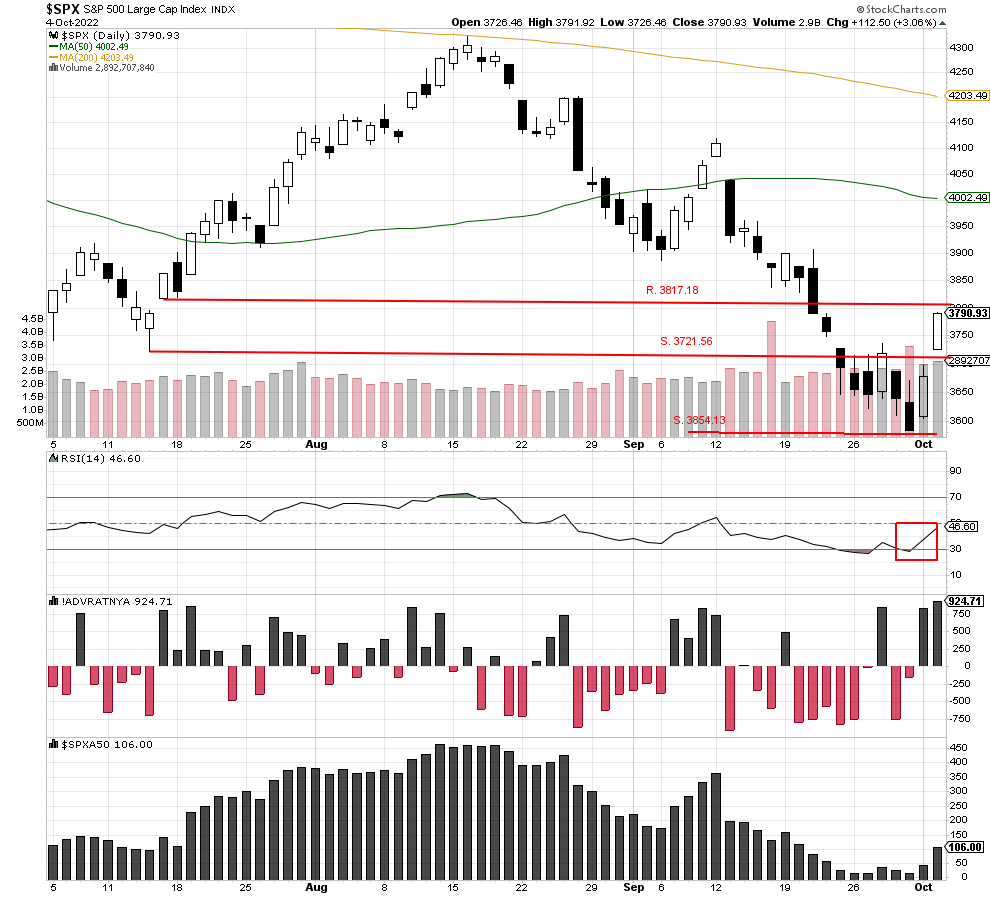Morning Brief

Headline News:
The S&P 500 futures are down 34 points and are trading 0.9% below fair value. The Nasdaq 100 futures are down 100 points and are trading 0.9% below fair value. The Dow Jones Industrial Average futures are down 287 points and are trading 0.9% below fair value.
Equity futures are weaker this morning after the big rally in recent sessions. There’s a feeling that the market got ahead of itself with the rebound effort and with thinking that the Fed would soften its approach soon.
The Reserve Bank of New Zealand raised its official cash rate by 50 basis points to 3.50%, as expected, and there was some debate about a 75 basis point hike. This move follows on the heels of yesterday’s decision by the Reserve Bank of Australia to raise its cash rate by only 25 basis points to 2.60%.
Today’s OPEC+ meeting is a focal point for market participants. The expectation is that OPEC+ will announce a production cut of 1.5 million barrels per day, according to The Wall Street Journal. Oil prices were on a tear in recent sessions but came well off their highs this morning. WTI crude oil futures, at $87.28/bbl a short time ago, are down 0.4% to $86.11/bbl.
In other news, Hong Kong’s Hang Seng surged 5.9% off its lowest level since late 2011 in a catch-up trade after global equity markets rallied while it was closed for a holiday on Tuesday.
Treasury yields are up this morning, keeping pressure on equity futures. The 10-yr note yield is up seven basis points to 3.69% and the 2-yr note yield is up five basis points to 4.13%.
The weekly MBA Mortgage Application Index showed a big 14.2% decline compared to last week’s 3.7% decline, as higher mortgage rates and Hurricane Ian weighed heavily on activity. Other economic data today includes:
(Michael Gibbs, Director of Equity Portfolio & Technical Strategy)
Markets:
The S&P 500 rallied again, moving past resistance at 3721.56 to close sharply higher at 3790.93. The trading came with volume of 2,892,707,840, of which 95% was upside volume. So, Tuesday’s trading is considered a follow-through day after Monday’s trading, and there is now a potential uptrend in place.
RSI moved higher in support of the rally closing higher at 46.60. So far this morning, S&P 500 futures are lower by 1.03%, with a suggested open of 3763.00. Profit-taking is expected after the index has rallied 5.8% in the last two days. Potential support could now come in at 3721.56, and we feel that level will not be tested today.
We are currently Intermediate-term bearish and short-term bearish.

John N. Lilly III CPFA
Accredited Portfolio Management Advisor℠
Accredited Asset Management Specialist℠
Portfolio Manager, RJFS
Partner, DJWMG
Windsor Wealth Planners & Strategist
Futures trading is speculative, leveraged, and involves substantial risks. Investing always involves risk, including the loss of principal, and futures trading could present additional risk based on underlying commodities investments.
The Relative Strength Index (RSI), developed by J. Welles Wilder, is a momentum oscillator that measures the speed and changes of price movements.
The advance/decline line (A/D) is a technical indicator that plots the difference between the number of advancing and declining stocks on a daily basis. The indicator is cumulative, with a positive number being added to the prior number, or if the number is negative, it is subtracted from the prior number.
The A/D line is used to show market sentiment, as it tells traders whether there are more stocks rising or falling. It is used to confirm price trends in major indexes and can also warn of reversals when divergence occurs.
The percentage of stocks trading above a specific moving average is a breadth indicator that measures internal strength or weakness in the underlying index. The 50-day moving average is used for short-to-medium-term timeframes, while the 150-day and 200-day moving averages are used for medium-to-long-term timeframes. Signals can be derived from overbought/oversold levels, crosses above/below 50%, and bullish/bearish divergences.
The Dow Jones Industrial Average (DJIA), commonly known as “The Dow,” is an index representing 30 stocks of companies maintained and reviewed by the editors of the Wall Street Journal. The Russell 2000 Index measures the performance of the 2,000 smallest companies in the Russell 3000 Index, which represent approximately 8% of the total market capitalization of the Russell 3000 Index.
The S&P 500 is an unmanaged index of 500 widely held stocks that is generally considered representative of the U.S stock market. Past performance may not be indicative of future results. Keep in mind that individuals cannot invest directly in any index, and index performance does not include transaction costs or other fees, which will affect actual investment performance. Individual investors’ results will vary. Opinions expressed are those of the author John N. Lilly III, and not necessarily those of Raymond James. “There is no guarantee that these statements, opinions, or forecast provided herein will prove to be correct. “The information contained was received from sources believed to be reliable, but accuracy is not guaranteed. Investing always involves risk, and you may incur a profit or loss. No investment strategy can guarantee success. The charts and/or tables presented herein are for illustrative purposes only and should not be considered as the sole basis for your investment decision. International investing involves special risks, including currency fluctuations, different financial accounting standards, and possible political and economic volatility. Investing in emerging markets can be riskier than investing in well-established foreign markets.
This is not a recommendation to buy or sell any company’s stock mentioned above.
US government bonds and treasury bills are guaranteed by the US government and, if held to maturity, offer a fixed rate of return and guaranteed principal value. US government bonds are issued and guaranteed as to the timely payment of principal and interest by the federal government. Bond prices and yields are subject to change based on market conditions and availability. If bonds are sold prior to maturity, you may receive more or less than your initial investment. Holding bonds to term allows redemption at par value. There is an inverse relationship between interest rate movements and bond prices. Generally, when interest rates rise, bond prices fall, and when interest rates fall, bond prices generally rise.
The Nasdaq 100 (^NDX) is a stock market index made up of 103 equity securities issued by 100 of the largest non-financial companies listed on the NASDAQ. It is a modified capitalization-weighted index. It is based on exchange, and it is not an index of U.S.-based companies.



